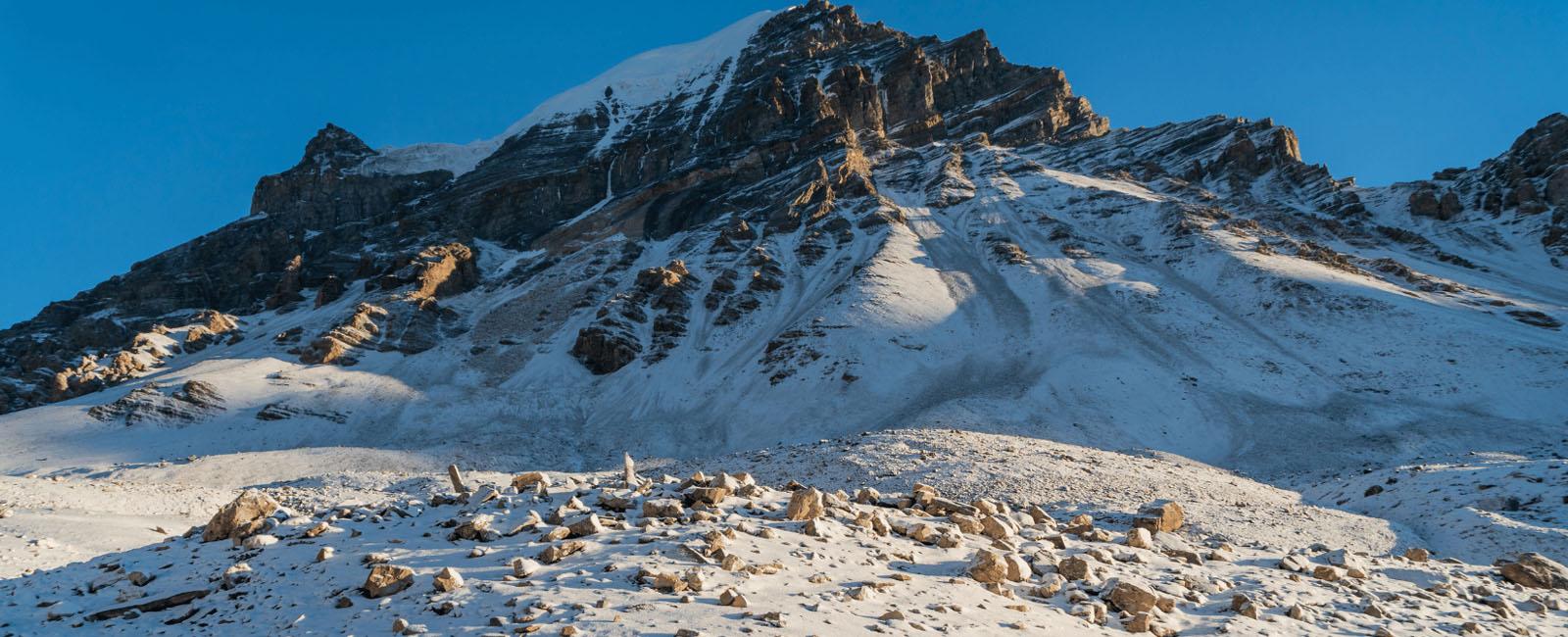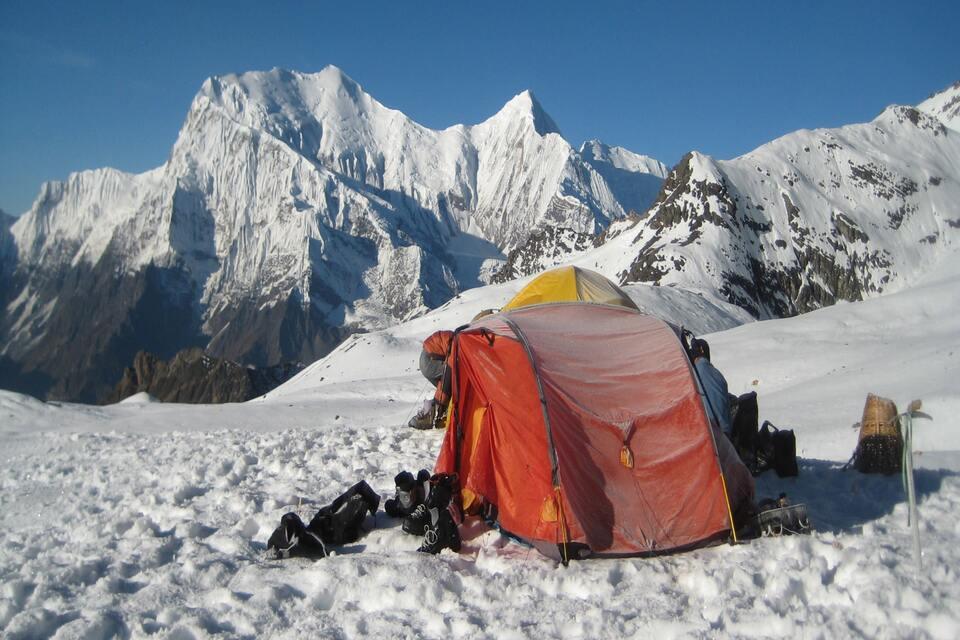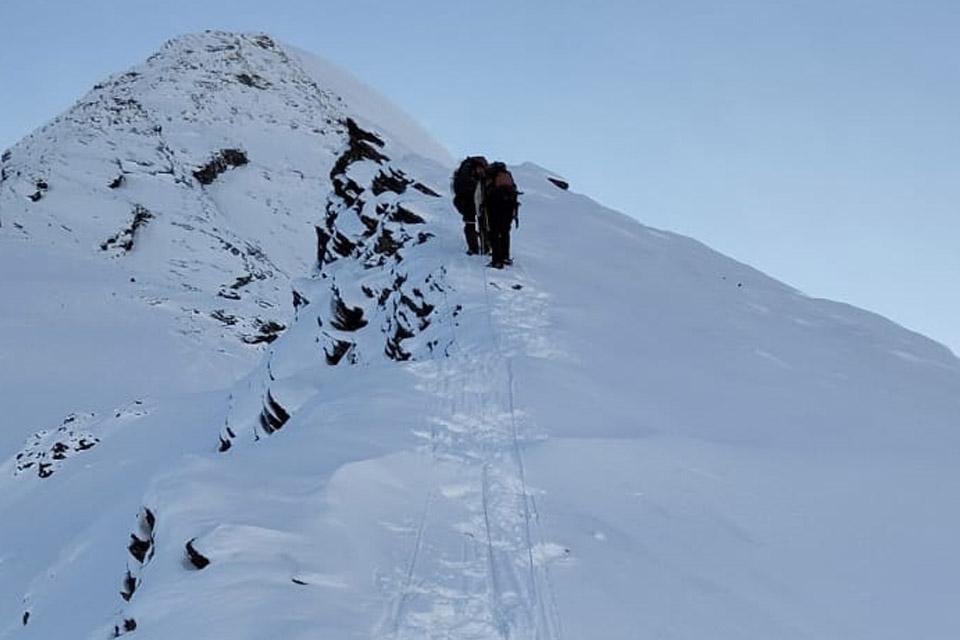Thorong peak climbing
Trip at a Glance
A popular destination for climbers seeking a non-technical climbing experience and one of the most scenic trekking routes in the Himalayas is Thorong Peak (6,144 meters/ 20,157 feet) located in the Annapurna region. This mountain, which is close to the well-known Thorong La Pass (5,416 meters), provides stunning views of the Annapurna and Dhaulagiri ranges in addition to insight into the area's rich cultural heritage.
Thorong Peak is regarded as the perfect peak for novice climbers aiming for their first Himalayan summit and is a great choice for trekkers and climbers who want to experience Himalayan mountaineering without going into technically difficult terrain. Climbers will be rewarded with an expansive views of the Tibetan Plateau, the Kali Gandaki Gorge, the Nilgiri, the Annapurna and Dhaulagiri Mountain ranges, and more from the summit.
Thorong Peak is located along the Annapurna Circuit trekking route in the Annapurna Conservation Area. One of Nepal's most well-known trekking routes, the Annapurna Circuit offers a combination of stunning scenery, cultural richness, and enthralling mountain adventures. The trekking becomes much more rewarding when combined with ascending Thorong Peak, which combines high-altitude trekking with a non-technical climbing experience.
Thorong Peak Climbing Highlights
- Witness spectacular views of Annapurna, Dhaulagiri, Nilgiri, and the Tibetan Plateau from the summit
- Cross the iconic high-altitude Thorong La pass (5,416 meters)
- Explore Tibetan-influenced villages, Buddhist monasteries, and the sacred Muktinath Temple.
- Ideal for beginner climbers who know the basic of mountaineering.
- Trek through lush valleys and alpine meadows to arid deserts and snowfields.
- Combines the classic Annapurna Circuit trek with a rewarding peak climbing experience.
Best Time to Climb Thorong Peak
The best time to for climbing Thorong Peak is during spring (March to May) and Autumn (September to November).
Spring (March to May):
Because of its comparatively stable weather, this season is very popular. Warmer temperatures and clearer sky are to be expected, which will improve visibility and create more comfortable climbing conditions. The region's beautiful charm is enhanced by the spring blossom.
Autumn (September to November):
After the monsoon season, autumn offers dry conditions and open skies, making it another great time of year for climbing. There are spectacular views of the surrounding mountains thanks to the clear air and good visibility. Particularly at higher elevations, temperatures are lower.
Monsoon Season (June to August):
Because of the heavy rainfall that can make paths dangerous and obstruct views of the mountains, it is strongly suggested to avoid climbing during the monsoon season.
Winter (December to February):
Because of the freezing temperatures and thick snowfall, winter climbing is very difficult. During this time, a lot of teahouses and facilities can be closed.
Thorong Peak Climbing Difficulty
Thorong Peak isnt’ a very technical climb, but there are parts that call for basic mountaineering knowledge. Using crampons and ice axes to get grip on snow and ice is one example of this. Climbers need to go through icy and steep hills. For safety in exposed areas, a good rope work is required. There are rocky trails, glacial areas, and snowfields, among other notable variations in the landscape. Climbers need to be ready for potentially slippery and rough terrain.
Trekkers need to be ready to hike for several days. Significant physical endurance is needed for long days of hiking and climbing at high elevations. Dealing with the lower oxygen levels at high elevations requires a high level of cardiovascular fitness. Even in the "best" seasons, the Himalayan weather is subject to sudden changes. Snowfall, high winds, and sudden temperature drops can be possible.
Acclimatization days must be on the itinerary. At 6,144 meters (20,157 feet), the summit of the peak takes climbers into the altitude sickness zone. Common symptoms include headaches, nausea, and dyspnea. A carefully planned itinerary that includes rest days and gradual ascents is crucial. It is important to spend time at lower elevations prior to attempting the top. Trekkers need to be conscious of how their bodies react to altitude and let their guides know if they have any symptoms.
How to climb Thorong Peak with Annapurna Circuit
Trekking the Annapurna Circuit and climbing Thorong Peak gives an already amazing trek a thrilling mountaineering adventure. Trekking from the Annapurna Circuit trail is the usual route to Thorong Peak. Thorong Peak should be carefully included in your Annapurna Circuit trek itinerary.
You need to allow extra days for both the actual climb and acclimatization. Good natural acclimatization by trekking the Annapurna Circuit. Make use of the trek's slow ascent to get your body used to Thorong Peak's higher elevation. Your itinerary should include acclimatization days, especially in Manang. The best time for climbing Thorong peak in the spring (March–May) and fall (September–November). The weather is most stable during these seasons.
Trekking the Annapurna Circuit requires Permit for Annapurna Conservation Area (ACAP). Thorong Peak requires a different climbing permit issued by the Nepal Mountaineering Association (NMA). By booking your trip with a recognized travel agent, they shall handle all the permits and paper works.
Climbing equipment required for Thorong peak includes ropes, crampons, ice axes, harnesses, helmets, climbing boots, and high-altitude-appropriate apparel. You need to make sure your equipment is in good shape including hiring an experienced guide with experience in mountaineering. They will be crucial for technical support, safety, and navigation.
On summit day, an early start will be necessary for the summit attempt. Pay close attention to what your advisor tells you. Be ready for difficult terrain and weather conditions. After summit, take the same path as the ascent and descend cautiously and safely.
Itinerary
Day 01: Arrival in Kathmandu
Day 02: In Kathmandu - Preparation Day
Day 03: Drive from Kathmandu to Jagat (1,300m/8-9 hrs)
Day 04: Trek from Jagat to Dharapani (1,950m/6-7 hrs)
Day 05: Trek from Dharapani to Chame (2,630m/5-6 hrs)
Day 06: Trek from Chame to Lower Pisang (3,200m5-6 hrs)
Day 07: Trek from Lower Pisang to Manang (3,550m/4-5 hrs)
Day 08: Acclimatization Day in Manang
Day 09: Trek from Manang to Yak Kharka (4,110m/3-4 hrs)
Day 10: Trek from Yak Kharka to Thorong Phedi (4,600m/4-5 hrs)
Day 11: Trek from Thorong Phedi to Thorong La Pass (5,416m/5-6 hrs)
Day 12: Preparation Day for Climbing
Day 13: Summit Thorong Peak (6,144m) & descend to Muktinath (3,760m/9-10 hrs)
Day 14: Contingency Day for Bad Weather
Day 15: Trek from Muktinath to Jomsom (2,800m/4-5 hrs) via Kagbeni
Day 16: Fly from Jomsom to Pokhara (820m/25 min)
Day 17: Fly or drive from Pokhara to Kathmandu (1400m)
Day 18: Final Departure
Arrive in Kathmandu and one of our representatives will receive you and transfer you to your hotel in Kathmandu. The rest of the time is free to explore the city or you can simply rest at your hotel if you are jet lagged and get ready for an amazing Himalayan trek/climb.
Our office team and climbing guide will meet you at the hotel and provide you further details regarding the trip completing your trip's paperwork and permission and conduct a last inspection of your climbing gear. You will have the opportunity to purchase any extra gear you may require today. Another option is to take a sightseeing tour of the Kathmandu Valley.
Early morning take a scenic drive from Kathmandu to Jagat leaving the bustling city behind and traveling through green hills, terraced fields, and charming villages. The route follows the Marsyangdi River and passes small settlements like Besisahar before reaching Jagat, a small village marking the start of the trek.
Today trek begins with a gradual climb through lush forests, terraced hillsides, and traditional Gurung villages. En-route, cross suspension bridges and enjoy views of cascading waterfalls. After passing Chamje, the trail ascends steeply to Dharapani, a village influenced by Tibetan Buddhist culture.
The trek continues through pine forests and alongside the Marsyangdi River passing villages like Bagarchhap and Danaque observing towering peaks like Lamjung Himal and Annapurna II. Soon Chame is reached, the district headquarters of Manang with stunning views of the Himalayas.
The trek continues through pine forests and alongside the Marsyangdi River passing villages like Bagarchhap and Danaque observing towering peaks like Lamjung Himal and Annapurna II. Soon Chame is reached, the district headquarters of Manang with stunning views of the Himalayas.
You will head through the arid upper Manang region enjoying spectacular views of Annapurna III, Tilicho Peak, and the Gangapurna Glacier. The trail passes through villages like Humde and Braga, known for its ancient Buddhist monastery. Arrive in Manang, a picturesque village surrounded by stunning mountains.
Today is rest/acclimatization in Manang exploring the surrounding area. Several options exists like short hikes to Gangapurna Lake, Bhojo Gompa, or the viewpoint above the village for stunning views. You can visit local bakeries and also learn about high-altitude lifestyles in the Himalayan Rescue Association (HRA) center in Manang.
You will ascend gradually, passing juniper and alpine meadows. The trail crosses wooden bridges and you can spot yaks grazing in the high pastures. The thinner air at this altitude requires a slower pace. Reach Yak Kharka, a small settlement used as a stopping point for acclimatization.
The trail goes through rugged terrain, gaining altitude steadily. You will cross a suspension bridge and climb a steep trail to Thorong Phedi, the base camp for the Thorong La Pass and Thorong Peak. Enjoy stunning views of the surrounding peaks from here.
Start early to tackle the challenging ascent to Thorong La Pass, one of the highest trekking passes in the world. You will go through steep and icy trail but with spectacular views of the Annapurna and Dhaulagiri ranges. After crossing the pass, descend to a suitable camp near Thorong Peak for summit preparation.
Today is spent acclimatizing and preparing for the climb. Your climbing guide will go over technical instructions, check equipment, and finalize the summit route. Rest and hydrate well to ensure optimal energy for the climb.
Start the climb before dawn to make the best out of the weather conditions. You will cross snowfields with moderate climbing using ropes and crampons. Upon reaching the summit, you will witness stunning 360-degree views of the Annapurna and Dhaulagiri ranges, Nilgiri including the Tibetan Plateau. Descend carefully and continue to Muktinath, a sacred pilgrimage site.
Today is a reserve for any potential delays due to poor weather or altitude sickness, ensuring a safer climb.
The trail descends through arid landscapes and crossing traditional villages like Kagbeni, famous for its Tibetan culture. Reach Jomsom, the gateway to the Mustang region and a big mountain town with many lodges, hotels, restaurants and also a small airstrip.
Take a scenic morning flight from Jomsom to Pokhara which offers spectacular aerial views of the Annapurna and Dhaulagiri Mountain ranges, Fishtail and the Kali Gandaki gorge below. Arrive Pokhara and the rest of the time is free to explore.
Fly back to Kathmandu (25 min) with scenic aerial views of the Himalayas. Upon arrival, explore the city or enjoy a farewell dinner. Drive from Pokhara to Kathmandu takes about 8-9 hours.
Today is your final day in Nepal. A representative of Marron Treks will escort you to the Tribhuvan International Airport, three hours to your flight schedule. Have a safe flight back home!
What is included?
- Airport pick-up and drop services.
- Hotel accommodations in Kathmandu & Pokhara with breakfast on Twin Share Basis.
- Kathmandu/Jagat drive by private vehicle.
- All trekking accommodations with Breakfast/Lunch/Dinner at local lodges & tents on twin-sharing basis.
- A comprehensive medical kit (will be carried by the trekking guide).
- Experienced government-licensed climbing guide & porters (1 porter for two people) including their food, accommodation, & salary.
- Group climbing gear like climbing rope, ice screws, snow bars etc.
- All camping equipment required during the climb (sleeping tents/mattresses, kitchen tent, kitchen equipment).
- Four seasonal sleeping bags and duffel bags (to be returned after trip completion)
- Personal insurance for climbing/trek crew.
- Jomsom/Pokhara by flight with guide.
- Annapurna Conservation entry permit & TIMS Card.
- Thorong Peak Climbing Permit.
- Pokhara/Kathmandu transfers by a tourist bus or private vehicle (Option: Flight)
- Farewell dinner with Nepalese cultural program.
- All government and local taxes.
What is not included?
- International airfares.
- Nepal entry visa fee – Visa can be obtained upon your arrival at the Tribhuvan International Airport in Kathmandu. (USD30 for 15 days)
- Lunch & dinner in Kathmandu or Pokhara.
- Personal travel insurance.
- Emergency rescue evacuation (to be covered by the client's travel insurance).
- Other expenses of a personal nature (phone calls, laundry, battery recharge, bottle or boiled water, hot shower etc.)
- Personal climbing gear.
- Bar bills, alcoholic drinks & beverages.
- Garbage deposit fees (refundable).
- Tips for guides and porters (Tipping is expected).
Trip Info
Accommodation
While you are in Kathmandu, we opt to accommodate you in 4- or 5-star hotels like Hotel Royal Singhi (4-star), Hotel Manaslu (4-star), Radisson (5-star), Yak & Yeti (5-star), or similar. During the trek, you will be accommodated in a local mountain lodge, better known as Tea House. These lodges and teahouses provide good services and are equipped with basic amenities. During the climb, we will provide top-quality camping equipment, including premium member tents, a spacious dining tent, and a hygienic toilet tent. We will endeavor to provide you with the best accommodation available along the route so that you get a good night’s rest in a hygienic milieu.
Meals
We never compromise the quality of food or the health of the trekkers as well as the crew members. Generally, we opt for the fresh and nutritional local community food available. You could make your delicious pick from an array of traditional foods like Sweet potatoes, buckwheat barley, etc. This way, you could not only get a real sense of the local culture and life patterns but also contribute to promoting the locally available resources of organic food and beverages. Besides, a wide range of Continental, Chinese, Italian and Indian cuisines like Pizza, Spaghetti, French Fries, Soups, Breads, Masala curry, etc. are also available in the restaurants for your retreat. During the camping, our experienced cook will prepare nutritious and hygienic meals for you.
Acclimatization
Altitude sickness is a serious risk while trekking in the Himalayas. It's important to acclimatize properly by spending a few days at lower altitudes before heading higher. By spending time at lower altitudes before pushing higher, your body has time to adjust. Our trekking packages have enough acclimatization days planned where you'll be spending a day or two at lower altitudes, allowing your body to adjust to the increasing altitude.
Electricity & drinking water
For an additional cost, you can use the electricity in all tea houses and lodges to recharge your batteries. The lodges have packaged mineral water for sale, or you can fill your bottle with boiling water. To make water drinkable, you can use water purification tablets too. But, due to hygienic issues, you should avoid drinking water from taps, rivers, or wells in trekking areas.
Communication
At lodges, restaurants, and hotels, Wi-Fi is available for an additional fee in the most popular trek regions, like Everest, and Annapurna. However, at high elevations, phone calls are the only means of connection. Our office in Kathmandu is in constant communication with your trek guide. In Kathmandu, you can purchase a local sim card for communication purposes. At high elevations, the mobile signal might not be as strong, though.
Luggage
Our porters are paired with one trekker for every two hikers, and one porter can safely carry 30 kg maximum weight. Therefore, we advise you to fill your duffle bag not more than 15 kg with your belongings. You may carry a small backpack with your valuables and informational documents. The things you are not taking along on the trek can be stored in a hotel in Kathmandu free of cost.
Typical Trek Day
Mostly your trek day starts with breakfast at 7-8 am, followed by a 3-4 hour morning trek. Lunch break is around an hour, then you continue trekking to your destination for the day. After reaching the teahouse lodge, you can relax, explore nearby areas, and enjoy dinner at 6-7 pm. Evenings involve socializing, a trek briefing, and leisure activities before bed.
Travel Insurance
It is advised that you arrange your travel insurance before leaving your homeland. The main thing is to make sure that your insurance covers you for both- medical and evacuation costs. Having travel insurance with you makes your trip secure and hassle-free.
Our Guides
Guides play a significant role during the trek. They are the ones who literally decipher the trekking codes for you so that you can actually connect with nature, culture and people along the way. We have helpful and dedicated trekking guides who are very well-versed in the culture, life patterns and every single detail pertaining to the trek region you are traveling in. Thus, in the company of our professional Sherpa guides, your trek becomes not only entertaining but also equally informative.
Porter and Staff Care
When it comes to high-altitude trekking, porters and staff members make up a pivot. Marron Treks ensures that all the porters and staff members going to high altitudes are provided with adequate clothing and equipment. All our field staff are covered by insurance.





